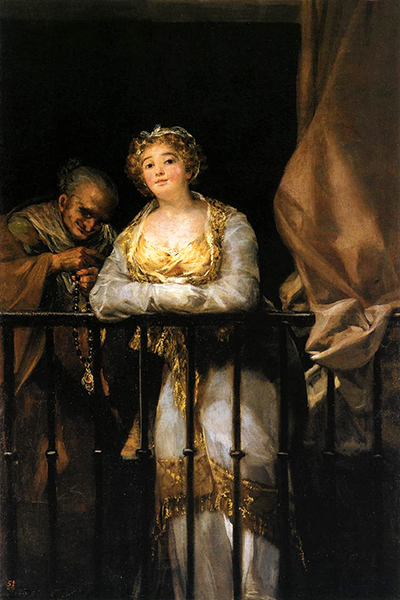Maja and Celestina on a Balcony is one of Francisco de Goya's not-quite-so-well-known paintings. It is a curious, intriguing picture that shows a stark comparison between the beauty of splendid youth and decrepit old age.
Maja and Celestina on a Balcony was painted between 1808 and 1812, a period of upheaval and distress for Goya: his beloved wife died and the country was at war. However, in this period he also painted The Colossus, The Water Bearer, The Knife-grinder and Majas on a Balcony, of similar inspiration to Maja and Celestina on a Balcony. Historically, 1808 was an important year: it marked the start of the Peninsular War between France and Spain. Later, Goya painted two masterpieces depicting harrowing episodes of the 1808 invasion: The Second of May and The Third of May.
She is young and beautiful. We see her full length; we can appreciate the fine luxury of her glorious gown with gold trim. Her pretty, round, youthful face and fine blonde hair make her appear a darling girl, while the sophisticated gown, with decolleté revealing a generous cleavage, suggests something more. She is leaning out over the balcony; she is on full display. This figure of a young woman reappears in other Goya paintings; she resembles the young lady in the frescoes that Goya painted in the San Antonio de la Florida Chapel in Madrid. Possibly, she is Leocadia Weiss, a particular friend of Goya's.
The other figure in the painting is Celestina: old, bent, ugly, decrepit. She is the antithesis of the bright solar presence of the Maja. She is concentrated on the bulky rosary in her hand, but her expression is mischievous and calculating. This figure is the Celestina from the literary work by Fernando de Rojas, first published anonymously in 1499. The character of Celestina is a lowly, scheming old woman who exploits people, especially young girls, for her own ends. In fact, the name Celestina has become synonymous, in Spanish, to mean procuress.
The picture focuses attention on the enticing Maja in the centre, then on the ugly, contrasting figure of Celestina nearby. We see the front railing of the balcony but, apart from a curtain to one side, there are no other details. The room behind the balcony is in complete darkness. Maja and Celestina on a Balcony (original title: Maja y Celestina en el Balcon), painted between 1808 and 1812, is oil on canvas, 166 x 108 cm. It currently hangs in a private collection, the Collection Bartolomé March, in Palma de Mallorca. The theme of Maja and Celestina reappeared in Goya's series of miniatures etched on ivory in 1825, and he also did a later drawing of Maja and Celestina under an Arch.




